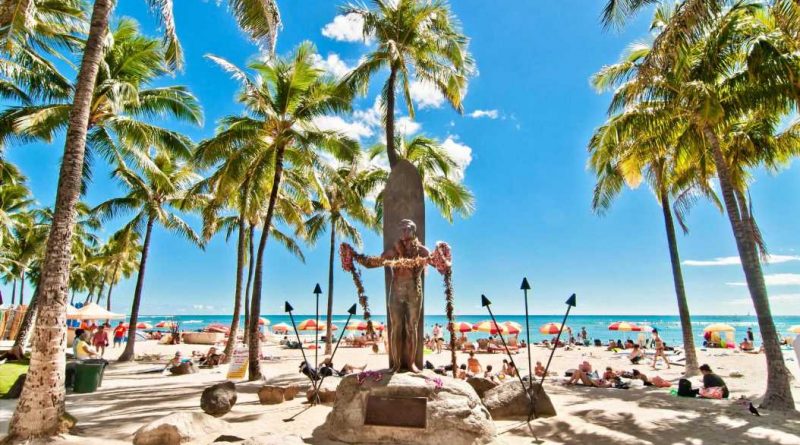A Look Back at Waikiki's Surf History—and Why It's Still the Best Place to Learn the Sport
Surfing is inherently tied to travel. What began as wave riding centuries ago in Polynesia has evolved into an international obsession that now compels surfers to chase waves all over the world. And although there is no consensus on which Polynesian island first invented surfing, most people can agree that the sport’s international journey began in Hawai’i , on one of the world’s most famous beaches: Waikiki.
Hawaiians have surfed these perfect waves since Waikiki was just a small village down the road from Honolulu. In more recent decades, many surf-curious travelers have taken their first lessons here: The conditions are notoriously calm, and perfect for beginners. Today the area looks different than it once did, clad with high-rise resorts and pricy restaurants. But don’t write it off as a tourist trap just yet—surfing here is a historic and cultural experience to be had, if you’re willing to paddle out for it.
With the sport scheduled to make its official debut at the Tokyo Olympic Games in July, a long-awaited milestone in the sports history, we look back at Waikiki’s surf heritage, and the best ways to experience it yourself.
In bustling Honolulu, the hallowed sand of modern surfing
In order to surf in Waikiki, it’s important to know the sport’s storied history. Back in 1810, after King Kamehameha united the islands of Hawai’i, and well before Hawai’i was part of the United States, the royal families of each island, or the ali’i, came together in Honolulu Bay. According to Brown, many of them visited the village of Waikiki to surf and eventually built their homes alongside the commoners and non-Hawaiians living in the area. Only native Hawaiians surfed in Waikiki—but upon the arrival of Protestant missionaries in the 19th century, the sport was discouraged across Hawai’i and nearly disappeared.
Other factors contributed to the decline of surfing during the 1800s, too, Brown says, including the introduction of diseases that killed many Hawaiians. “Hawaiians still surfed, particularly in the country … [it] just kind of went out of favor, perhaps being seen as old-fashioned.”
Surfing’s revival would not occur until almost a century later, when tourists visiting Waikiki in the 1920s took interest in the Hawaiians who seemed to be walking on water. Waikiki’s waters are shallow, and the reef offshore creates gentle, long waves, which give novice surfers plenty of time to stand up and earn their ride—ultimately making Waikiki the preferred spot for surfing Hawaiians to teach foreigners the sport. “Surfing became first something for visitors to watch from a distance, and then to try themselves,” says DeSoto Brown, a historian at the Hawai’i State Museum of Natural and Cultural History.
Because the boards were made of solid wood, the sport was at first only attempted by the most adventurous visitors. But even they didn’t go out on their own, they hired “beach boys”—surfers who made a living teaching tourists, showing off on the beach, and honing their own skills on Waikiki’s calm waves. According to Brown, “a beach boy was pretty much required for anyone learning to surf, just to carry the board to and from the water.”
Kalani Ka’anā’anā, the Hawai’i Tourism Board’s Director of Cultural Affairs, says that beach boys weren’t just there to give lessons and shuttle heavy boards in and out of the water though. “It was about keeping people safe and making sure that visitors who wanted to try surfing did so in a way that was respectful of the people who were already there and who called the place home.”
The beach boys of Waikiki were the first ambassadors of surfing, and among their ranks in the 1920s emerged the Olympian and three-time gold medalist swimmer Duke Kahanamoku, whose travels around the world spawned surf schools across the globe. Although there were many instances of Hawaiians exhibiting their surf skills abroad, experts agree Kahanamoku is the father of modern surfing. He gave surfing exhibitions in Australia and Southern California that seeded the sport’s interest on new shores, but his story began on Waikiki as a beach boy, helping visitors unlock the thrill of their first wave.
Surf instructor Tammy Moniz of the Moniz Family Surf School says Khanamoku “took the spirit of Hawai’i with him and shared his passion and the culture of surfing with foreign places, and taught in Waikiki in the same sand that we teach [today].” Hawaii would not become a state until 1959, long after Kahanamoku traveled the world to share the sport of surfing, but by then it was already a marker of sun-soaked luxury for mid-century American travelers—an era started by the Moana Surfrider, the first luxury hotel to open on Waikiki in 1901, and perpetuated by the many hotels that followed in the 1950s.
Waikiki has since been a postcard destination of Hawai’i and surfing, and despite its many evolutions, that surf history and culture remains the heartbeat of the destination. American travelers keep on coming—many, with the hopes of learning to surf.
How to catch a wave yourself
There are surf spots across Hawai’i where you can catch a wave to feel like Duke, but the island of Oahu offers the most variety for surfers of different skill levels. Of course, Waikiki is the easiest spot to surf for its shallow, calm conditions.
Waikiki Beach: Many hotels on Waikiki can help you arrange surf lessons, but you can also schedule a lesson with a private surf school like the Moniz Family Surf, Ty Gurney Surf School, or Ohana Surf Project. There are eight breaks on Waikiki; in layman’s terms, specific spots in the water where waves consistently form and break. For your first time surfing, going out with a teacher and staying in Waikiki is strongly recommended, especially in a place with so many other beginners in the water. “When it comes to Waikiki, the danger isn’t in the waves but in the people, because everyone’s learning,” Moniz says. “It’s good to take a lesson, so we can help keep you as safe as you possibly could be.”
The North Shore of Oahu: To stay dry and see the pros at work, head to the other side of Oahu, the North Shore, where the high-stakes sport of big-wave surfing came to be. You can find expert surfers riding monster waves on Waimea Bay and getting tubed on the Banzai Pipeline break all year round, but if you want to see how big the waves can get, visit in the winter when swells bring 40-footers. Pro surfers often need to wear impact vests and helmets for waves this big, but spectators can stick with a beach blanket and a pair of binoculars.
As you enjoy the surf riches of the island, remember that you are a visitor, after all. “Tourism came after a long and illustrious history of native Hawaiians in this place,” Hawai’i Tourisms’s Ka‘anā‘anā says. It was the aloha of the first watermen and women of Oahu that built the relationship between Hawaiians and foreigners, and to respect that is to understand that surfing in Waikiki is a privilege.
Source: Read Full Article



